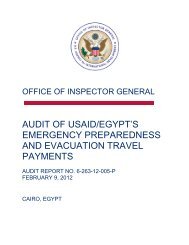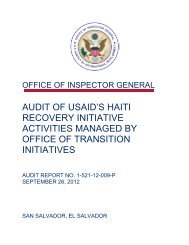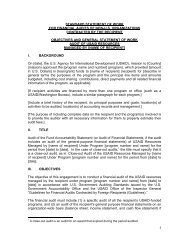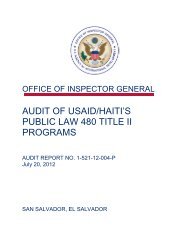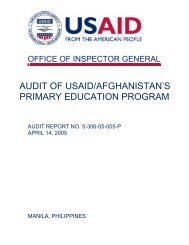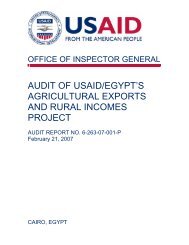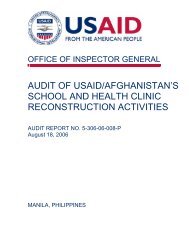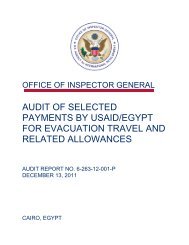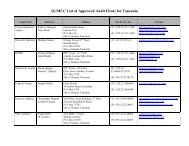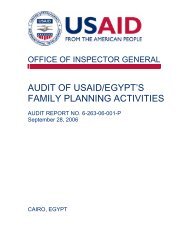USAID OIG Afghanistan and Pakistan Oversight Report, April-June ...
USAID OIG Afghanistan and Pakistan Oversight Report, April-June ...
USAID OIG Afghanistan and Pakistan Oversight Report, April-June ...
- No tags were found...
Create successful ePaper yourself
Turn your PDF publications into a flip-book with our unique Google optimized e-Paper software.
The project had many successes, including the completion of more than 2,500 community stabilizationprojects; generation of immediate short-term employment totaling 1.5 million employment days throughcash-for-work activities; <strong>and</strong> completion of significant <strong>and</strong> lasting improvements in rural infrastructure,including gravel roads, footbridges, <strong>and</strong> irrigation systems. However, in March 2011, <strong>OIG</strong> received a copy ofa DAI internal audit report detailing financial <strong>and</strong> internal control problems occurring from August 2008through August 2009. DAI had not provided this report to <strong>USAID</strong> or returned any funds related toquestioned expenditures identified in the report.Procurements for the project, including service contracts, fuel supply, <strong>and</strong> building <strong>and</strong> vehicle leases hadseveral deficiencies. For instance, analysis of payment vouchers <strong>and</strong> the associated procurement documentsrevealed $2,019,036 in noncompetitive procurements. In addition, <strong>OIG</strong>’s review of leases for office space<strong>and</strong> guesthouses, at an amount of $6.7 million over 4½ years, revealed that project personnel had enteredinto several leases without the required competition <strong>and</strong> without required approvals. In addition, somerental payments were apparently made to the project cashier, instead of to the lessors identified in the leaseagreements. DAI staff explained that because many of the property owners did not have bank accounts,lease payments needed to be in cash. <strong>OIG</strong> found no documentation showing that the lessors had signed forreceipt of their monthly rents.Furthermore, <strong>OIG</strong> determined the contract files for three vehicle leasing companies lacked preawarddocuments, bid solicitations, other vendors’ quotations, <strong>and</strong> approvals from DAI procurement managers. Inone incident, a bid submitted for one procurement (to provide armored <strong>and</strong> unarmored vehicles) wascopied <strong>and</strong> included as proof of competitive bidding in another procurement, <strong>and</strong> correction fluid had beenused to obscure relevant information. DAI staff members were also unable to locate the contract file,payment vouchers, or project receipts for fuel purchases totaling $3,424,400 from Khyber AfghanPetroleum, one of DAI’s suppliers. DAI staff had no explanation for this lack of documentation.Audit of <strong>USAID</strong>/<strong>Afghanistan</strong>’s <strong>Afghanistan</strong> Stabilization Initiative for the Southern Region (<strong>Report</strong>No. F-306-12-001-P, November 13, 2011)In <strong>June</strong> 2009, <strong>USAID</strong>’s Office of Transition Initiatives (OTI) signed a 3-year, $159.6 million contract withChemonics International Inc. (Chemonics) to implement the <strong>Afghanistan</strong> Stabilization Initiative for theSouthern Region. Under the initiative, Chemonics implemented project activities through grants in districts<strong>and</strong> municipalities in K<strong>and</strong>ahar <strong>and</strong> Helm<strong>and</strong> Provinces.<strong>OIG</strong> was unable to reach a conclusion about whether the program as a whole was achieving its goal becauseof multiple weaknesses in program implementation: a lack of formal work plans, inadequate OTI oversight,staffing difficulties, <strong>and</strong> poor-quality subcontractors. In addition, Chemonics did not properly manage itsbudget <strong>and</strong> began running out of funds in the first quarter of FY 2011.Some security costs incurred for the initiative were questionable. Chemonics paid $1.2 million for personalsecurity details for staff members who lived on military bases <strong>and</strong> traveled exclusively in military convoys,even though no other contractor incurred this type of cost when the contractor’s staff members resided on amilitary installation.Furthermore, Chemonics had leased 13 armored vehicles because officials in the company felt the vehicleswere needed to provide sufficient security. However, Chemonics’ security personnel prohibited expatriate70 <strong>USAID</strong> <strong>OIG</strong> <strong>Afghanistan</strong> <strong>and</strong> <strong>Pakistan</strong> <strong>Oversight</strong> <strong>Report</strong>



